Stone Beings ~ Interconexiones Minerales . SYNchronies of TErritory and MEmory in Re-existence
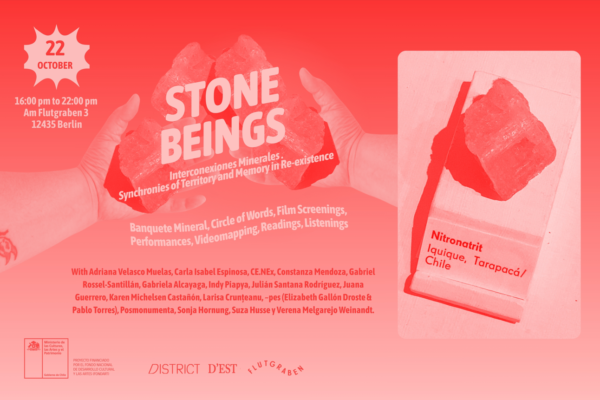
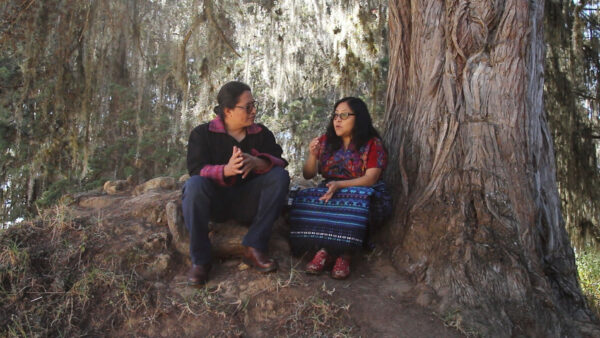
Dra. Cumes & Kaypa' Tz'iken_FQE, Flores que explotan, película de Karen Michelsen Castañón, 2023
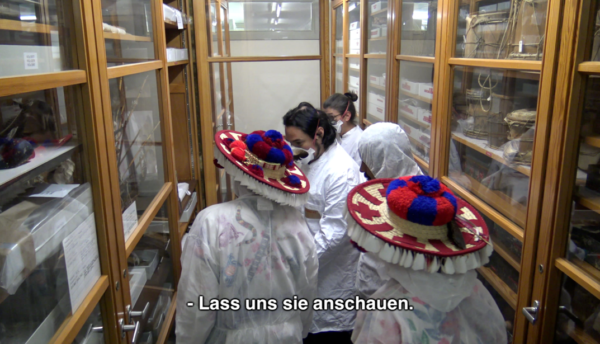
Los Lobos. Segunda visita y reencuentro con las ofrendas Wixárika en Dahlem, Berlín, película de Gabriel Rossel-Santillán, 2017-2022
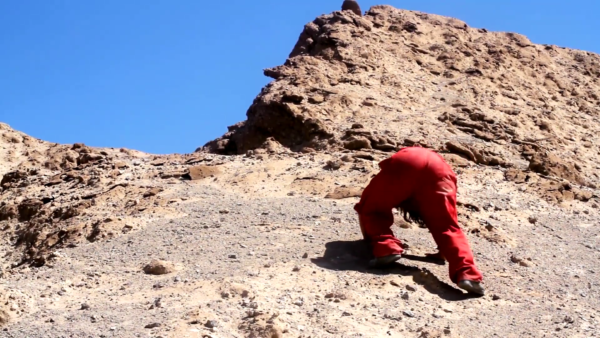
Caliche: sangre y muerte, película de Juana Guerrero y Gabriela Alcayaga, 2015 (03:37 min)
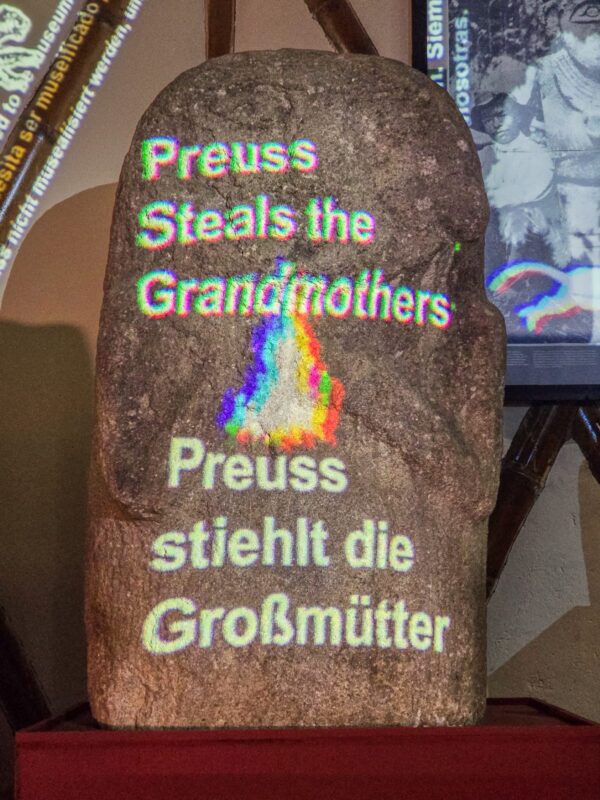
Abuelas de Piedra (Stone Ancestors), Museo Comunitario San Agustín - Museo de Obando, Projection by Posmonumenta, 2025
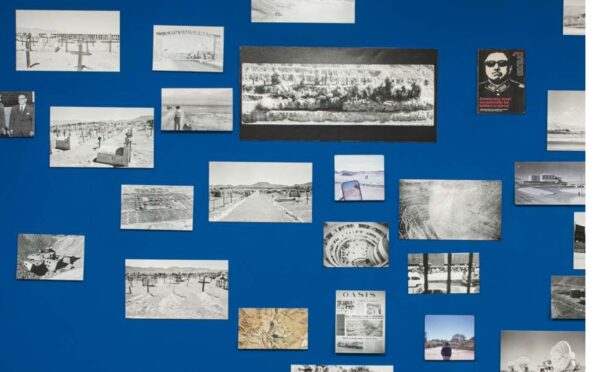
Mining the Self. Acto I: No le deseo una identidad a nadie, performance de Constanza Mendoza
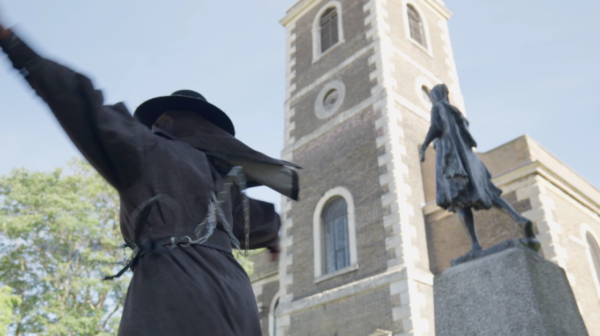
inku. Encounter- Performance (work in progress), video work by Verena Melgarejo Weinandt, 2025
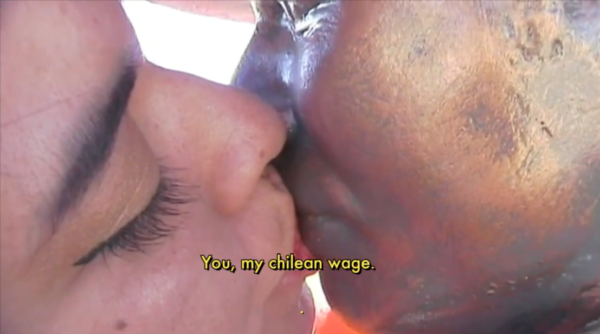
CUporn: película de CENEx (ex colectivo de Juana Guerrero, Isabel Torres y Lucía Egaña), 2021
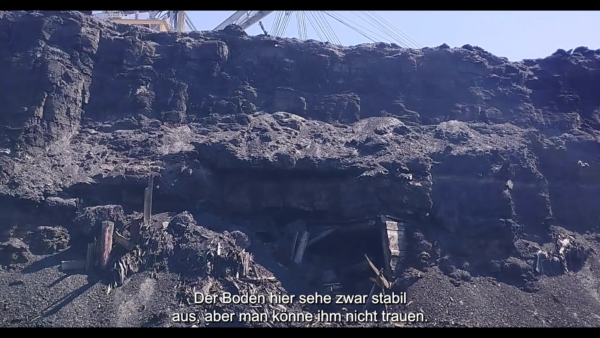
Larisa Crunțeanu & Sonja Hornung, Untitled (to slip, to slide, to glitch), still from a mixed media installation, 2024
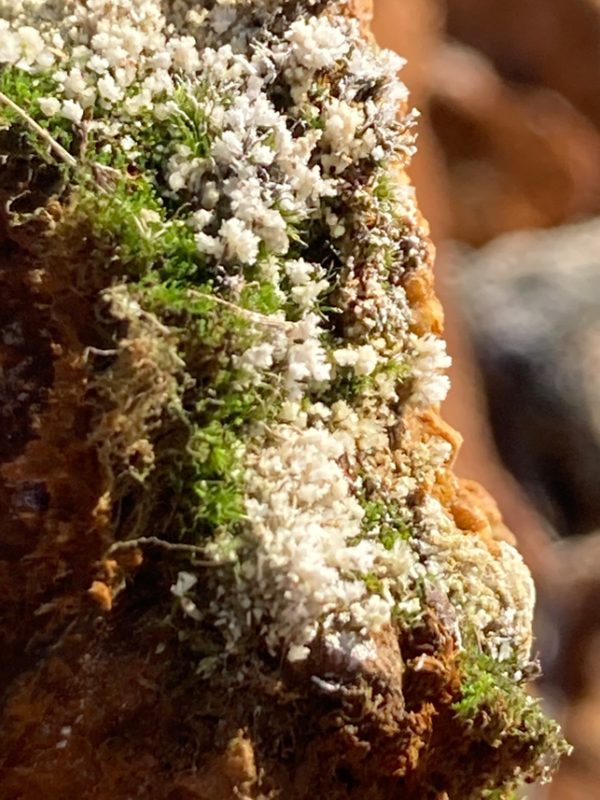
22 October 2025
16:00-22:00
Flutgraben e.V. / Project Space
Am Flutgraben 3, 12435 Berlin
Banquete Mineral, Circle of Words, Film Screenings, Performances, Videomapping, Readings, Listenings
with Adriana Velasco Muelas, Carla Isabel Espinosa, CENEx, Constanza Mendoza, Gabriel Rossel-Santillán, Gabriela Alcayaga, Indy Piapya, Julián Santana Rodríguez, Juana Guerrero, Karen Michelsen Castañón, Larisa Crunțeanu, ~pes (Elizabeth Gallón Droste & Pablo Torres), Posmonumenta, Sonja Hornung, Suza Husse, Verena Melgarejo Weinandt
Multilingual event in Español, English, Namtrik, Runa Shimi, Wixárika, Deutsch. Translations will be offered into Español and Spanish
16:00 ANTICOLONIAL TECTONICS
Las Piedras Hablan / The Stones Speak – Welcome
Flores que explotan, film by Karen Michelsen Castañón, 2023 (excerpt)
Caliche: sangre y muerte, film by Juana Guerrero y Gabriela Alcayaga, 2015 (03:37 min)
Los Lobos. Segunda visita y reencuentro con las ofrendas Wixárika en Dahlem, Berlín / Zweites Zusammentreffen und Befragung der Wixárika Opfergabe in Berlin, film by Gabriel Rossel-Santillán 2017-2022 (16:43 min)
Tectonic Bones Radio. Tonight There are Ancestors on Every Channel, reading with Suza Husse
17:00 TOWARD THE RETURN OF THE STONE ANCESTORS
SYNchronies of TErritory and MEmory in Re-existence: Circulo de Palabra / Circle of Words led by Adriana Velasco Muelas, Indy Piapya, Carla Isabel Espinosa, Julián Santana Rodríguez, Posmonumenta
Videomapping by Posmonumenta: projections of a growing visual archive of the processes in relation to the rematriation of the “Stone Grandmothers” with Veeduría, Aiso and the Misak community organisations
18:30 BANQUETE MINERAL
Performance and food by Juana Guerro y Gabriela Alcayagaer
with la tinga, collective contribution led by Gabriel Rossel-Santillán
19:00 COPPER
Mining the Self. Act I: I Wish No One An Identity, performance by Constanza Mendoza
CUporn: film by CENEx (ex collective of Juana Guerrero, Isabel Torres y Lucia Egaña), 2021 (10:42 min)
Tinku. Encounter- Performance (work in progress), video work by Verena Melgarejo Weinandt, 2025 (09:04 min)
20:00 LIGNITE, SICK WATERS
to slip, to slide, to glitch, video works by Larisa Crunțeanu and Sonja Hornung, 2024 (excerpts)
Estancias, 2021 (3 min) and Finding Andrónico, 2018 (4 min), films by Juana Guerrero y Gabriela Alcayaga
Talking to you, dead water!, listening with ~pes (Elizabeth Gallón Droste & Pablo Torres), 2022, 17:36 min
Seres de Piedra ~ Interconexiones Minerales: SYNchronies of TErritory and MEmory in Re-existence
Seres de Piedra ~ Interconexiones Minerales: SYNchronies of TErritory and MEmory in Re-existence is a program organised by district*school without center and D’EST at Flutgraben e.V. to celebrate the intersection of two cosmoses related to stone beings and mineral interconnections:
Interconexiones Minerales is an artistic research and residency program. It connects mining and post-extraction ecologies in Tarapaca and East Germany through transdisciplinary collaborations between artists, researchers, activists and local communities. In different ecologies, archives and institutions, in joint journeys, conversations and ceremonies, Interconexiones Minerales interacts with wounded landscapes, toxic residues and invisibilized memory of extraction cultures and environments. A particular focus is on embodiment at the crossings of social and ecological spheres: How do earth, rocks, and minerals such as lignite, uranium, saltpeter, copper, and lithium pass through collective and individual bodies and are deposited in them? How is their extraction, processing, and use expressed in emotional and psychosocial dimensions?
A program initiated by Juana Guerrero, Gabriela Alcayaga and Suza Husse with district * school without center, Berlin, D’EST and Flutgraben e.V.
SIN TEMER 2025: SYNchronies of TErritory and MEmory in Re-existence is an artist residency program connecting Colombia and Germany through decolonial methodologies. In October 2025, a delegation brings together three indigenous leaders—Adriana Velasco Muelas and Indy Piapya (Misak people), and Carla Isabel Espinosa (Yanakuna people, Veeduría por la Repatriación del Patrimonio del Macizo Colombiano)—alongside members of the collective Posmonumenta (Julian Santana Rodríguez) and Berlin based artists, activists and cultural workers. The visit focuses on the rematriation of the “Stone Grandmothers”, 133 sacred stone beings looted in 1914 in San Agustín, which are held captive at the Ethnological Collections at the Humboldt Forum in Berlin. In the long process toward rematriation, the group amplifies anticolonial demands to recognize the role of indigenous peoples and community processes in the return of these ancestors to their places of origin. Alongside the interactions with the “Stone Grandmothers” in the museum, and advancing concrete actions toward their return, the delegation seeks to strengthen transterritorial solidarity networks, and share healing and resistance methodologies.
16:00 ANTICOLONIAL TECTONICS
Las Piedras Hablan / The Stones Speak – Welcome
Flores que explotan, film by Karen Michelsen Castañón, 2023 (excerpt)
“Flores que explotan” (Karen Michelsen Castañón / 2023) centers the roots and continuities of the colonial economy from the perspectives of Mayan communities in Iximulew/Guatemala. Speakers in the film are Kaqchikel communities from San Juan Sacatepéquez resisting the “Progreso” cement factory, lawyer Juan Castro from the Indigenous Peoples’ Law Office, Dr. Aura Cumes, and economist/poet Kaypa’ Tz’iken.
Caliche: sangre y muerte, film by Juana Guerrero y Gabriela Alcayaga, 2015 (03:37 min)
In Caliche: Blood and Death, the artist ascends a heap of mining tailings —a residue of extractive activity— that blends with the natural hills of the desert. Dressed in a red overall, under the blazing midday sun, she breaks rocks with her hands, exposing physical effort, exhaustion, and the fragility of the body against the vast arid landscape.
The simple, obstinate action reveals the invisible traces of extractivism and its persistent forms of violence. The gesture of climbing and fragmenting the mineral material becomes a way of conversing with the earth—an attempt to touch, to open, and to resist the hardness of the territory.
Los Lobos. Segunda visita y reencuentro con las ofrendas Wixárika en Dahlem, Berlín / Zweites Zusammentreffen und Befragung der Wixárika Opfergabe in Berlin, film by Gabriel Rossel-Santillán 2017-2022 (16:43 min)
The video shows conversations between Mara’akate, the artist, and the staff of the Dahlem Museum after participating in two ceremonies. In the museum, where each participant was renamed, the Mara’akate searched for images of extinct animals and plants as well as ceremonial utensils with drawings, patterns, and/or techniques that contained information about textile methods that no longer exist in Wixárika communities. In addition, the video shows how the Mara’akate rearranged the ceremonial utensils in the museum and explains the importance of maintaining a correct order of non-human (material) objects. Based on their knowledge, this order is important for the well-being of humanity.
Tectonic Bones Radio. Tonight There are Ancestors on Every Channel, reading with Suza Husse
Tectonic Bones Radio continues a series of transmissions organized by Suza Husse in the summer of 2024 as part of the anti-colonial platform When the Jackal Leaves the Sun: Decentering Restitution | Pedagogies of Repossession. As expressions of speculative tectonics, these moments weave a space to trace the tremors and transformative frequencies triggered by the presence of indigenous human and more-than-human ancestors and so-called ancestral remains, which to this day are held against their will in German museums, collections, research institutions, and private homes.
17:00 TOWARD THE RETURN OF THE STONE ANCESTORS
SYNchronies of TErritory and MEmory in Re-existence: Circulo de Palabra / Circle of Words led by Adriana Velasco Muelas, Indy Piapya, Carla Isabel Espinosa, Julián Santana Rodríguez, Posmonumenta
Videomapping by Posmonumenta – projections of a growing visual archive of the processes in relation to the rematriation of the “Stone Grandmothers” with Veeduría, Aiso and the Misak community organisations
The Circle of Words focuses on the rematriation of the “Stone Grandmothers”, 133 sacred stone beings looted in 1914 in San Agustín, which are held captive at the Ethnological Collections at the Humboldt Forum in Berlin. In the long process toward rematriation, the group amplifies anticolonial demands to recognize the role of indigenous peoples and community processes in the return of these ancestors to their places of origin. The Circle of Words follows a methodology based on Misak ceremonial protocol and is open to broad participation. It is facilitated by
Adriana Velasco Muelas – Misak leader, guardian of ancestral medicine,
Anthropology student. Former Mayor of the Misak Cabildo in Bogotá (2023),
delegate on environmental issues for AISO.
Indy Piapya – Misak leader, ethno-educator, delegate to the National Intersectoral
Commission for Historical Reparation. Active in memory, gender, and youth from an
anti-colonial perspective.
Carla Isabel Espinosa – Yanakuna leader, agricultural engineer, cultural manager,
and activist of the Veeduría por la Repatriación del Patrimonio del Macizo
Colombiano. Central figure in the struggle for the restitution of the “Stone
Grandmothers”
Julián Santana Rodríguez – Visual artist, coordinator of Posmonumenta and the
SIN TEMER 2025 exchange. Artistic coordinator of the labs and videomapping
processes.
18:30 BANQUETE MINERAL
Performance and food by Juana Guerrero y Gabriela Alcayaga
with la tinga, collective contribution led by Gabriel Rossel-Santillán
Mineral Banquet is a performance event that transforms the table into territory, archive, and surface for thought. Spread across it is a tablecloth printed with a collage of images—geological, technological, and domestic—that form a map of mineral interconnections: the minerals that traverse the earth, the human body, food, and electronic circuits. The banquet proposes an impossible scene: celebrating the abundance of what the earth offers, but facing the awareness of its depletion.
A table suspended between the edible and the inedible, between offering and waste.
Banquete Mineral invites us to think about what we ingest, literally and symbolically.
A performance that transforms the table into an archive of the links between earth, body, and technologies, inviting us to taste matter as a shared language.
19:00 COPPER
Mining the Self. Act I: I Wish No One An Identity, performance by Constanza Mendoza
The performance excavates the impacts of colonialism, imperialism, and dictatorship on the history of Chile, my family, and myself through a multi-scalar approach. I delve into the engineered and sanitized rhetoric that shapes the physical environment and conceals the colonial dispossession of populations in local sacrifice zones, from Tierra del Fuego to the Atacama Desert, where land and people are discarded for larger geopolitical and economic projects. “Mining The Self” attempts to embody a counter-transparent self that remains a relational and collective mode of resistance, despite the constant threat of being co-opted and silenced.
CUporn: film by CENEx (ex collective of Juana Guerrero, Isabel Torres y Lucia Egaña), 2021 (10:42 min)
CENEx (Centro de Estudios de la Naturaleza Extractiva, English: Center for the Study of Extractive Natures) is a platform for researching extractive natures and exploited natures from modernity to the present day. It was founded in Chile in 2020 by artists and researchers Lucía Egaña, Juana Guerrero, and Isabel Torres with the aim of conducting interdisciplinary research into extractive practices. A particular focus is placed on the relationship between extraction and epistemology, or the shaping of life forms in connection with “raw materials” on planet Earth.
CUporn is the second video in the trilogy “Wild Diaries of Porn and Extraction”, functioning as a series of mixed poetic and heretical notes, of conflicting affections at the intersection of a territory and its representation. It rejects official historicity through narratives that emphasize the relentless and insensitive suckings and drillings of the pornographic account of neoliberal extraction—in this case, of copper.
Tinku. Encounter- Performance (work in progress), video work by Verena Melgarejo Weinandt, 2025 (09:04 min)
This performance took place in Gravesend, England, where Pocahontas was buried after she died on a ship that was supposed to bring her back to Virginia/ USA. This is a place where the performance encounters and confronts the violence enacted through the fiction, fantasy and imaginaries about her, ignoring and making her real life and violence she had to endure, invisible.
20:00 LIGNITE, SICK WATERS, PETROL, GAS
to slip, to slide, to glitch, video works by Larisa Crunțeanu and Sonja Hornung, 2024 (excerpts)
“Yet upon (re)visiting the sites in question, we became disoriented. We were overwhelmed by the vastness of the scars left behind by mining, the patchily covered-up displacement of villages and their cemeteries, of trees and their bones; the many fences; the glitching, unstable ground. We were uneasy about the apparent feminisation of the landscape present in discourses on mining, rehabilitation, and repair. We dreamed up a guide, a fixer of places and images, to show us the way and give us the answers, but she disappeared…”
The body of work to slip, to slide, to glitch unfolded out of Larisa Crunțeanu and Sonja Hornung’s encounters with two mining landscapes—of lignite in Lusatia, East Germany, and copper and gold in the Apuseni Mountains, Romania. The artworks, which include textile cyanotypes, handmade artificial plants, video, sound, and a repurposed bike, explore glitches in the attempts to control and repair landscapes produced by ‘green’ capitalism. Excerpts from the video installation will be shown.
Estancias, 2021 (3 min) and Finding Andrónico, 2018 (4 min), films by Juana Guerrero y Gabriela Alcayaga
In Estancias, Juana Guerrero positions herself in the southernmost reaches of Chile, in Tierra del Fuego. From there, the artist reflects on the forms of colonial and industrial invasion that have radically transformed the territory. The old cattle ranches—symbols of dispossession and colonization—coexist with industrial infrastructures that reenact the occupation of the landscape under new extractive logics. Through a silent and restrained action, Guerrero embodies the female presence in a historically patriarchal territory, where bodies have been shaped by violence and exploitation. Her gesture becomes a testimony to a persisting history: the land as a stage of conquest, labor, and resistance.
Finding Andrónico imagines the depletion of mineral resources and foretells the end of capital. In this work, the artist embodies an ultra-stereotyped feminine aesthetic, globally circulated and commodified by the entertainment industry. Her body, made-up and performative, enacts desire and obedience: she becomes the figure celebrated and consumed by neoliberalism.
Through parody, the artist subverts the codes of media-driven femininity to expose their inherent violences. In her pursuit of Andrónico —an allegorical figure of capitalist love— a toxic love relationship unfolds: a mutual dependency between the earth and those who exploit it, between the female body and the system that eroticizes, exhausts, and discards it.
Talking to you, dead water!, listening with ~pes (Elizabeth Gallón Droste & Pablo Torres), 2022, 17:36 min
the planned end of coal mining brings with it not only socio-structural change but also the reshaping of the landscapes that have been formed by open cut mining. in a tour to lausitz, am ende landschaft traces ongoing devastation caused when entire villages are engulfed by mines, confronts state-led attempts at re-naturalisation and reflects embodied experiences with extraction and its consequences.
talking to you, dead water! is an on-site live listening session that dialogues with the molecular processes of the renatured coal mining landscape of Lake Grosssräschen. buoys, underwater speakers, hydrophones, sound and performative texts address the dead water, the aesthetic rhetoric of rescue and the volatile mercury bodies of the coal industry
